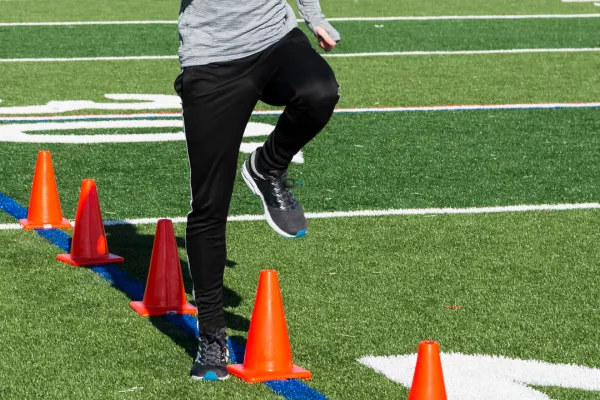
The Power of Play: Why Free Play is Essential for Youth Athletes at Every Age
In an era where structured training, club sports, and specialized coaching dominate youth athletics, the value of free play is often overlooked. Yet, research consistently shows that unstructured play is critical for a child’s cognitive, emotional, and physical development. Free play not only enhances creativity and problem-solving but also improves decision-making, social skills, and long-term motivation in sports (Côté, Lidor, & Hackfort, 2009).
The Science Behind Free Play
Studies in developmental psychology and sports science highlight the profound impact of free play on young athletes. According to research published in the Journal of Motor Learning and Development, children who engage in self-directed play demonstrate greater adaptability, resilience, and game intelligence compared to those in solely structured environments (Memmert, 2015). Neuroscientists have also found that play activates the brain’s prefrontal cortex, which governs decision-making and impulse control, key skills for athletic success (Pellis, Pellis, & Bell, 2010).
Moreover, research from the Aspen Institute’s Project Play underscores that early sports specialization, which limits free play, often leads to burnout, injuries, and decreased long-term participation in sports (Jayanthi et al., 2013). In contrast, athletes who engage in diverse, unstructured play environments show increased retention in sports and a stronger love for the game.
Incorporating Free Play by Age Group
To maximize the benefits of free play, coaches must intentionally integrate it into their training sessions. Here’s how coaches can introduce play at different age levels:
Ages 6-9: Learning Through Exploration
At this stage, kids are developing fundamental movement skills and learning how their bodies interact with the environment. They thrive in creative and exploratory play.
Ideas for Incorporating Free Play:
Game-Based Warm-ups: Instead of traditional drills, start practices with tag games, obstacle courses, or relay races that encourage movement in different planes.
Small-Sided, Rule-Free Games: Set up 3v3 or 4v4 games without rigid rules. Let kids create their own variations—maybe they play without goalkeepers, use a different scoring method, or introduce a “power-up” rule.
Equipment Play: Provide different balls, cones, or hoops and allow players to invent their own games before or after practice.
Ages 10-13: Developing Creativity and Decision-Making
In this age range, kids begin refining skills and understanding strategy, but free play remains essential for creativity and self-confidence.
Ideas for Incorporating Free Play:
Street-Style Scrimmages: Create pickup-style games with minimal coach intervention. Allow players to officiate and modify rules themselves.
Position Swaps: Let players experiment with different positions in an informal scrimmage to develop a well-rounded understanding of the game.
Challenge Games: Encourage players to create their own skill challenges—who can juggle the ball the longest, who can score from the furthest distance, or who can come up with a new trick move?
Ages 14+: Ownership and Self-Directed Play
Teen athletes are often under intense pressure to perform, making free play an essential outlet for stress relief and enjoyment.
Ideas for Incorporating Free Play:
Open Play Days: Designate one day per month as a “player-led” practice, where athletes design the session themselves.
Creative Constraint Games: Offer challenges such as “you can only score with your weaker foot” or “every pass must be one-touch” to keep the game fresh and engaging.
Mixed-Generation Play: Organize games where older athletes play alongside younger players in a mentorship setting, fostering leadership and community while having fun.
Conclusion: A Call to Coaches
As youth sports continue to evolve, it’s crucial that we resist the urge to over-structure every aspect of training. Free play is not wasted time-it is a vital ingredient in developing well-rounded, adaptable, and passionate athletes. By intentionally integrating free play into practices, we help young athletes unlock creativity, problem-solving skills, and a lifelong love for movement and sport.
This week, set aside at least 15 minutes of practice for unstructured free play. Observe how your athletes respond and share in the comments-chances are, you’ll witness increased energy, engagement, and joy. After all, the best athletes are the ones who truly love to play.
Read more blogs like this from Coach Julie:
Fitness is a Privilege not a Punishment
A Cornerstone of Effective Coaching: Mastering EQ
The Mental Agility Ability: A Game Of Adjustments in Coaching
Flipping the Switch-How Great Coaches Show Up When It Matters
An Unwritten Rule of Coaching Athletes
Your Daughter Is Going Pro pro…probably not.
Understanding Learning Styles of Female Athletes: Amplifying Performance Through Tailored Coaching
Coaching Female Athletes-The Art & The Science
What Every Coach Needs to Know About the Female Athlete’s Hormonal Cycle
If you enjoyed this article and know other coaches and trainers who could benefit from the content in this blog, please share in your social media channels.
About the Author:
Julie is an Author, CEO and Coach. She is the Brand Executive at the IYCA, the President & Founder of the Non-Profit Beyond The Game Alliance where they offer a full suite of workshops and support for teams, coaches and parents. In addition to her work as a business consultant and coach of coaches, leaders and entrepreneurs.
Julie is a Speed Development Specialist and Inner-Game Coach at the college, high school and youth levels.
Visit Julie’s Author Page

References
Côté, J., Lidor, R., & Hackfort, D. (2009). ISSP position stand: To sample or to specialize? Seven postulates about youth sport activities that lead to continued participation and elite performance. International Journal of Sport and Exercise Psychology, 7(1), 7-17.
Jayanthi, N., Pinkham, C., Dugas, L., Patrick, B., & Labella, C. (2013). Sports specialization in young athletes: Evidence-based recommendations. Sports Health, 5(3), 251-257.
Memmert, D. (2015). Teaching tactical creativity in sport: Research and practice. Routledge.
Pellis, S. M., Pellis, V. C., & Bell, H. C. (2010). The function of play in the development of the social brain. American Journal of Play, 2(3), 278-296.








